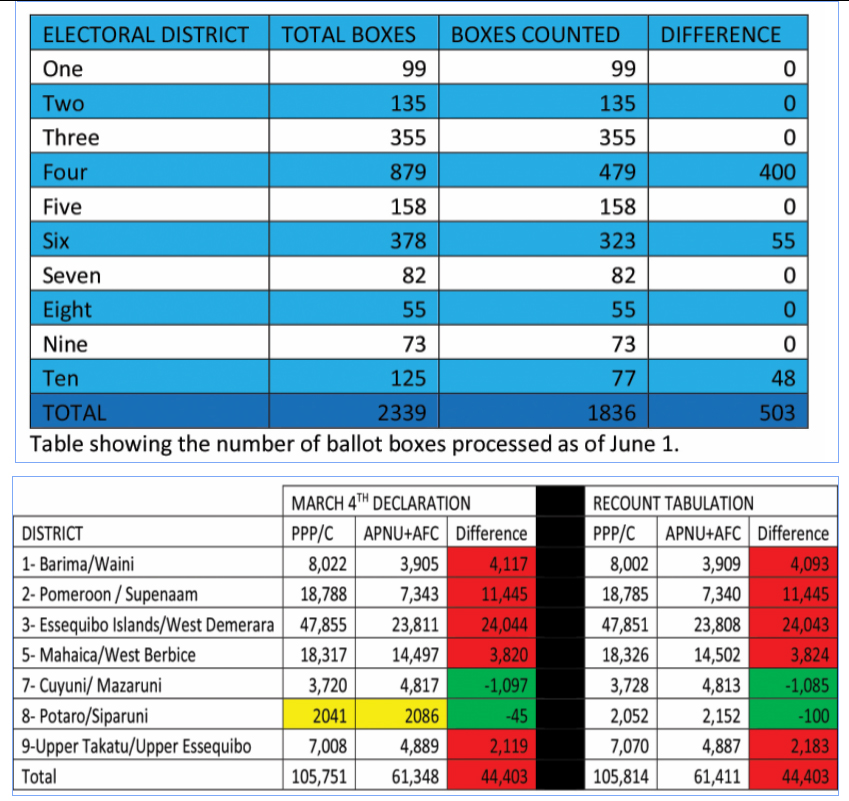The Guyana Elections Commission (GECOM) is 97 boxes closer to the completion of the National Recount however the body is no closer to a decision on how to respond to the various “irregularities” raised by the incumbent APNU+AFC.
Government-nominated Commissioner Desmond Trotman told Stabroek News last evening that the meeting of the Commis-sion scheduled for yesterday was postponed to today when it was discovered that one commissioner who was participating virtually did not possess the necessary documents.
According to Trotman, the “primary issue” on the agenda of the reconvened meeting is likely to be the information received from Chief Immigration Officer, Leslie James.
On May 27, James in response to a query from Chairperson, Justice (ret’d) Claudette Singh furnished the Commission with a list of 172 persons, their dates of birth, and travel records. These persons according to the incumbent APNU+AFC were recorded as having cast a ballot on March 2 even though they were out of the jurisdiction.
In total, according to GECOM Public Relations Officer, Yolanda Ward, the APNU+AFC on March 20 submitted 207 names which were forwarded to James. Stabroek News understands that a second list has since been provided.
Questions have however been raised as to whether there is definitive proof that these persons would have voted. Asked whether the Commission confirmed that the listed individuals had cast a ballot before submitting their names to James, Ward said no.
“It’s the party’s list…GECOM’s list is the list that is in the box…Those boxes have been sealed and are back in the container, once the box has been recounted, it’s resealed with all the contents back into then container. The parties will have lists,” she explained.
Ward repeatedly noted that the Commission has not made a decision on what to do with the information.
“The commission is to decide on how to move the process forward,” she stressed.
Meanwhile, Ward explained that 97 boxes had been processed yesterday. That number included 36 boxes in District Four, 33 in District Six, 26 in District 10 and two in District Nine. Currently the Commission has completed the recount of all boxes in seven of the ten districts and has now assigned five of the 12 workstations to District Four, four to District Six and three to District 10.
The tabulated General Statement of recounts equals 1,780 while 1,776 of the Regional Statements have been tabulated.
As the count draws to a close the incumbent APNU+AFC continues to refuse to sign the declarations which are being generated. Yesterday specifically GECOM issued the certified tabulation for District Eight. This tabulation shows the APNU+AFC winning the District with 2,152 votes compared to 2,052 secured by the People’s Progres-sive Party/Civic (PPP/C).
Rejected ballots across these seven districts at the General Elections were 1,846. Specifically there were 380 in District One, 251 in District Two, 485 in District Three, 256 in District Five, 164 in District Seven, 113 in District Eight and 196 in District Nine.
At the Regional level a total of 2290 was registered. This includes 328 in District One, 380 in District Two, 618 in District Three, 374 in District Five, 227 in District Seven, 134 in District Eight and 229 in District Nine
Ward noted that the Statement of Recount does not state which of the four available reasons resulted in the rejections but ex-plained that these reasons include “want of official mark”, unmarked or void for uncertainty, marked for more than one candidates list or marked so that the elector can be identified.
The Commission has not tabulated the number of ballots that would have been rejected solely for “want of official mark” that is absence of the six-digit identifying stamp for polling stations. The public relations officer however explained that the difference between the rejected ballots at the two elections could have resulted from a ballot paper being stamped at the top where the General Elections ballot is located and not at the bottom where Regional ballots are located.
The incumbent coalition has argued that a significant number of disciplined services ballots were not stamped as required on polling day. However, a cursory examination of the number of rejected ballots at “intermixing” stations does not support this assertion.
The two “intermixing” stations in District One, which were both located at the Mabaruma Primary, recorded a total of six rejected ballots. None of these ballots were rejected because of a “want of official mark”, the legal term used for an unstamped ballot.
In District Two, the seven intermixing stations had 12 rejected ballots. Of that number, three were rejected for “want of official mark”.
In District Three an examination of 14 of the 36 stations found a mere 12 rejected votes, of which none were for want of official mark. In District Five, a similar examination of 19 of the 36 stations found 30 rejected votes, none of which were for want of official mark. Finally in District Six, which is still being counted, there were up to yesterday 36 rejected votes at the 16 intermixing stations examined and none were for want of official mark.






